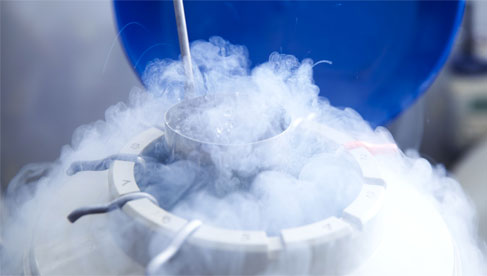Specially designed cryogenic containers with maximum damage resistance are used for cryoshipping.
For professional shipping of frozen samples are used liquid-nitrogen containers. Known also as vapour shippers, these containers offer a way to keep samples frozen while they move from one location to another.
Shipping containers are designed for the safe transportation of biological samples. Made from durable, lightweight aluminium, using a hydrophobic compound which absorbs the liquid nitrogen to ensure dry, spill-free vapour-phase shipping. These containers allow to ship your samples with "non-hazardous" classification throughout the world, thus reducing costs and assuring sample viability.
What is it cryogenic?
Cryogenics means the production of and behaviour of materials at very low temperatures. Rapidly moving molecules have a higher temperature than slower moving molecules. For example, while water transforms from a liquid to a solid at 0° C, cryogenic temperatures range much lower; from -150°C to -273° C.
What is a cryogenic container?
Cryogenic containers are double-walled vacuum vessels with multi-layer insulation in the annular space. They are designed for the reliable and safe transportation of frozen samples.
What are cryogenic containers made of?
Cryogenic containers are made from alloy aluminium foam performing features such as variable porosity, variable density, high surface area to unit volume, isotropic load response & variable stress strain characteristics.
What container can hold liquid nitrogen?
Only impact resistant containers that can withstand the extremely low temperatures can hold liquid nitrogen. Materials such as carbon steel, plastic and rubber become brittle at these temperatures. It is essential for shippers to use only approved containers for such a use.
What is liquid nitrogen?
Liquid nitrogen is the most commonly used element in cryogenics. Liquid nitrogen (LN2) is a liquid version of nitrogen (N2) gas. Liquid nitrogen is inert, colourless, odorless, noncorrosive, extremely cold and inflammable.
Does liquid nitrogen need to be refrigerated?
Since it is obtained from the atmosphere, liquid nitrogen is inexpensive and is rarely refrigerated. It is kept in insulated containers called Dewars and is allowed to boil away. Since it is boiling, the liquid nitrogen used in laboratories is at a temperature of -195.95° C.
What it is a Dewar container?
A Dewar is a double walled vacuum jacketed container, used to keep cryogenic liquids well insulated, preventing them from boiling to a gaseous state. The term can get confusing because technically any vacuum insulated container can be called a Dewar, from small open mouth flask, to large pressurized cylinders.
How the temperature inside the container is monitored?
To be able to monitor temperature all the time, modern containers are equipped with temperature logger, device for temperature levels control and data recording. Loggers are specially designed for measurement at ultra-low temperatures. The temperature data inside the container are recorded regularly.
Reliable modern technologies for safe cryoshipping are essential for transport of your cells. Make sure, your IVF courier uses top-class devices from renowned world manufacturers to ensure complete safety of the cells transported.
Is cryoshipping of your cells safe? Learn more on our blog: Is transport of frozen cells really safe?

